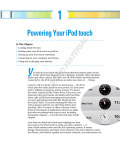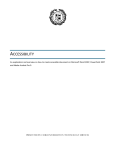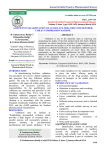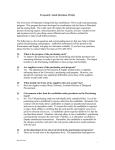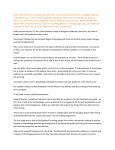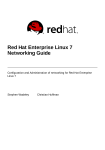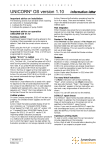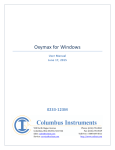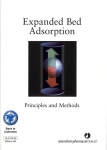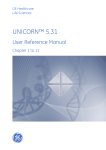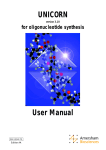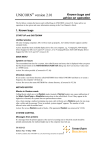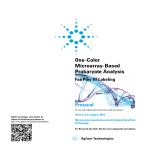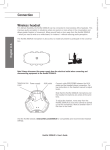Download unicorn 5.0n - GE Healthcare Life Sciences
Transcript
UNICORN 5.0N UNICORN Validation Support Package for UNICORN 5.0N 04-0021-58 Edition AB / January 2004 UNICORN 5.0N TABLE OF CONTENTS 1. INTRODUCTION TO THIS DOCUMENT ........................................................................... 1 2. INTRODUCTION TO UNICORN VALIDATION................................................................ 1 2.1. 2.2. 2.3. GENERAL UNICORN INFORMATION .......................................................................................... 1 VERSION NUMBERING ............................................................................................................... 3 INDEPENDENT UNICORN AUDITS ............................................................................................. 4 3. AMERSHAM BIOSCIENCES QUALITY MANAGEMENT SYSTEM ................................. 7 3.1. 3.2. 3.3. INTRODUCTION ........................................................................................................................ 7 PROTEIN SEPARATIONS QUALITY POLICY ................................................................................... 7 ISO CERTIFICATION ................................................................................................................. 7 4. PRODUCT DEVELOPMENT ............................................................................................... 9 4.1. 4.2. 4.3. 4.4. INTRODUCTION ........................................................................................................................ 9 DEVELOPMENT MODEL ............................................................................................................. 9 SERVICE, MAINTENANCE AND SPAREPARTS .............................................................................. 13 ERROR REPORTING ................................................................................................................. 13 5. COMPUTERIZED SYSTEM VALIDATION ...................................................................... 14 5.1. 5.2. 5.2.1. 5.2.2. 5.3. 5.3.1. 5.3.2. 5.3.3. 5.3.4. 5.3.5. 5.3.6. 5.3.7. 5.4. 5.4.1. 5.4.2. 5.4.3. 5.4.4. 5.5. 5.5.1. 5.5.2. 5.5.3. 5.5.4. 5.6. 5.6.1. 5.6.2. 5.6.3. 5.6.4. 5.6.5. 5.6.6. 5.6.7. INTRODUCTION ...................................................................................................................... 14 DESIGN & SPECIFICATION PHASE ............................................................................................. 14 Functional Requirements .................................................................................................... 14 System Specification .......................................................................................................... 14 HARDWARE INSTALLATION & QUALIFICATION PHASE ............................................................... 14 System Description with Schematic Drawings...................................................................... 14 Piping & Instrument Drawing ............................................................................................. 14 Instrument List .................................................................................................................. 15 Input/Output List ............................................................................................................... 15 Wiring Checks................................................................................................................... 15 Component Qualification.................................................................................................... 15 Calibration ........................................................................................................................ 15 SOFTWARE DEVELOPMENT / VERIFICATION PHASE .................................................................... 15 Quality Assurance Methods for Software Development......................................................... 15 Process Operating Logic..................................................................................................... 15 Program Description (Application Code) ............................................................................. 16 Software Structural Description........................................................................................... 16 SYSTEM INTEGRATION AND VERIFICATION PHASE ..................................................................... 16 Module Level Verification.................................................................................................. 16 Program Level Verification................................................................................................. 16 System Level Verification .................................................................................................. 17 Additional Software Verification Requirements.................................................................... 17 OPERATIONAL PHASE ............................................................................................................. 17 Change Control.................................................................................................................. 17 System Recovery Plan........................................................................................................ 17 Operating Manuals............................................................................................................. 18 Training of Personnel ......................................................................................................... 18 Support Personnel .............................................................................................................. 18 System Security ................................................................................................................. 18 Operating Procedures ......................................................................................................... 18 Edition AB / January 2004 UNICORN 5.0N 6. VALIDATION OF A UNICORN BASED CHROMATOGRAPHY SYSTEM...................... 19 6.1. 6.2. 6.2.1. 6.2.2. 6.2.3. 6.3. 6.4. 6.5. 6.5.1. 6.5.2. 6.5.3. 6.5.4. 6.5.5. 6.5.6. 6.5.7. 6.5.8. 6.6. 6.6.1. 6.6.2. 6.7. 6.8. 6.8.1. 6.8.2. 6.9. INTRODUCTION ...................................................................................................................... 19 DESIGN, VALIDATION PLAN AND ACTIVITY SCHEDULE .............................................................. 21 Design and Requirements analysis....................................................................................... 21 Validation Plan .................................................................................................................. 21 Activity Schedule............................................................................................................... 21 INSTALLATION QUALIFICATION (IQ) ........................................................................................ 26 OPERATIONAL QUALIFICATION (OQ) ....................................................................................... 26 METHOD DEVELOPMENT AND VERIFICATION ............................................................................ 26 Product Specification ......................................................................................................... 27 Method Development Plan.................................................................................................. 28 Process Optimization.......................................................................................................... 28 Method Construction.......................................................................................................... 28 Backup / Restore................................................................................................................ 29 Verification ....................................................................................................................... 30 Operating Instructions ........................................................................................................ 30 Revalidation ...................................................................................................................... 30 EDUCATION ........................................................................................................................... 31 System education ............................................................................................................... 31 Method education .............................................................................................................. 32 VALIDATION APPROVAL ......................................................................................................... 32 VALIDATION OF PC-BASED NETWORKS .................................................................................... 32 Introduction....................................................................................................................... 32 Validation strategy ............................................................................................................. 32 INSTALLATION QUALIFICATION AND OPERATIONAL QUALIFICATION SERVICES FROM AMERSHAM BIOSCIENCES FAST TRAK VALIDATION ..................................................................................... 34 7. REFERENCES .................................................................................................................... 34 Edition AB / January 2004 UNICORN 5.0N 1. INTRODUCTION TO THIS DOCUMENT This support package is valid for all UNICORN™ versions 5.0N. The last (third) digit has been replaced with a letter “N”. (see 2.2 in this document) The document has been assembled to provide important information on the development and documentation of UNICORN 5.0N. It will assure system owners that UNICORN has been developed in a structured manner, and verified in accordance with the System Development Life Cycle concept. The proper development, verification, and documentation are vital to the functionality and performance of UNICORN when in operation at a customer’s site, and should, accordingly be of interest to system owners. This document gives an overview of how UNICORN is developed. It would have been desirable to include all the documents created during the development of UNICORN 5.0N in this information package, but this is not practical and realisable. Customers, who wish to verify the existence of the documentation and development procedures, may perform audits in Uppsala and/or in Umeå, Sweden. This document provides a comprehensive description of the validation of the UNICORN system that controls ÄKTA™, BioProcess™, OligoPilot™, and OligoProcess™ systems. It also suggests a validation order and documentation that may be generated through the different steps in the validation procedure. Installation Qualification and Operational Qualification services available through Amersham Biosciences Fast Trak Validation are described in section 6.9. A standardised source-code escrow agreement for UNICORN can be ordered through Amersham Biosciences Fast Trak Validation. 2. 2.1. INTRODUCTION TO UNICORN VALIDATION General UNICORN information Amersham Biosciences UNICORN system affords state-of-the-art control over Amersham Biosciences chromatography systems, providing a level of sophistication and refinement not available in other competitive chromatography control systems. The configurable nature of UNICORN allows considerable variation in systems to meet the requirements of an individual customer. These activities involve the participation of both Amersham Biosciences and the system’s owner from the start of the purchasing activity through system start-up at the owner's location. Each UNICORN system is delivered with the same software, but many of its capabilities can only be accessed if the particular system itself is equipped for that specific function. The sophistication of the software allows even the most complex chromatographic separations to be implemented since they can be assembled from software components included with each UNICORN. Amersham Biosciences has a unique knowledge how FPLC™, ÄKTA, BioPilot™, BioProcess, OligoPilot and OligoProcess systems have been developed and verified. To system owners, this knowledge and documentation should be of interest in the validation process, assuring that Amersham Biosciences utilises procedures and documentation which complies with accepted standards throughout the pharmaceutical industry. Edition AB / January 2004 1 UNICORN 5.0N The following picture, UNICORN validation, illustrates the relations between the system owner, Amersham Biosciences and activities and documentation which should be involved in the validation process for a UNICORN based chromatography system. U N IC O R N V alidation S ystem O w ner B M I P r o te in S e p a r a tio n s U N IC O R N System D oc M ethod Installation Documentation provided or available from Amersham Biosciences Support available from Amersham Biosciences Fast Trak S ystem O wners input or d ocum e ntation BMI refers to the instructions and procedures used by Amersham Biosciences in the development of the system. See Section 3 Amersham Biosciences Quality Management System. System Owner is the person at the users site who is responsible for the correct functioning of the system. UNICORN refers to the documentation produced during the development of UNICORN. System Doc is the system-specific documentation supplied to the system owner from fabrication and final testing of the individual system. Installation refers to the Installation Qualification and Operational Qualification (IQ and OQ) for the system. These document templates can be ordered separately from Amersham Biosciences Fast Trak Validation by the customer, but are not a part of the documentation delivered with the system. Method refers to the customer’s method development and other relevant procedures (i.e. education of users). These procedures are described in more detail in the Section Validation of a UNICORN based Chromatography System. Protein Separations is the knowledge and activities needed to optimize the process as the choice of chemicals, media, product materials, buffers, etc. Edition AB / January 2004 2 UNICORN 5.0N 2.2. Version numbering When UNICORN software is changed/modified, the numbering system is used to indicate which degree of modification has been performed. The following text describes the principles used. The version number used consists of 3 digits and is written X.YZ. Example: 4.12. X – New version • new operating system • major new functionality Y-Update • • adaptations for new hardware components minor new functionality Z – Bug fix • correction of software errors • no new functionality; specifications not extended • software manual not affected Bug fixes are separate from updates, new functionality and new version releases. When X is incremented, Y and Z are set to zero. When Y is incremented, Z is set to zero. The following versions of UNICORN have been released from Amersham Biosciences (in chronological order) : UNICORN version Released Operating system 1.00 Dec. 1992 OS/2 1.01 Feb. 1993 OS/2 1.10 Sept. 1994 OS/2 1.11 Dec. 1994 OS/2 1.12 Feb. 1995 OS/2 2.00 Dec. 1995 OS/2 2.01 Feb. 1996 OS/2 2.10 Apr. 1996 OS/2 2.20 Oct. 1996 OS/2 2.30 Feb. 1997 OS/2 3.00 May 1998 Windows NT 2.33 May 1999 OS/2 3.10 May 1999 Windows NT 3.20 Nov. 1999 Windows NT 3.22 March 2001 Windows NT 4.00 May 2001 Windows NT/2000 4.11 June 2002 Windows NT/2000 4.12 July 2003 Windows NT/2000/XP 5.00 January 2004 Windows 2000/XP Edition AB / January 2004 3 UNICORN 5.0N OBSERVE ! Upgrading software in a system may have an impact on its functionality, and a revalidation may be necessary. This should be evaluated prior to performing any modification or upgrading of the software. 2.3. Independent UNICORN Audits Already when the first version of UNICORN was developed, an independent company, Weinberg Associates Inc. audited the principles and procedures employed by Amersham Biosciences in the development of UNICORN. As a result of this audit, Amersham Biosciences obtained a certificate, which confirms that the development model complies with relevant regulatory standards. Compliance with the FDA 21 CFR Part 11 was obtained starting with UNICORN 3.2. Certificate and audit report from UNICORN 5.0 is included in this support package. Edition AB / January 2004 4 UNICORN 5.0N Edition AB / January 2004 5 UNICORN 5.0N Edition AB / January 2004 6 UNICORN 5.0N 3. 3.1. AMERSHAM BIOSCIENCES QUALITY MANAGEMENT SYSTEM Introduction Amersham Biosciences´ quality management system, BMI (Business Management Information), is based on a process and system approach as described in the Protein Separations Quality Manual. It encompasses the steering structures and procedures needed to achieve the business objectives. 3.2. Protein Separations Quality Policy The Quality System should support the strategy of Protein Separations by assuring quality through active management of the following: • • • 3.3. Identification and documentation of customer needs. Development, manufacturing and delivery of products and services to meet or exceed those needs consistently. Feedback from customer assessment leading to improvement in performance for Protein Separations, minimising cost and complaints. ISO Certification ISO 9000 is an internationally accepted series of quality management standards. Certification requires rigorous auditing by an independent accredited agency which examines the quality documentation system and confirms that the organisation actually operates in accordance with stipulated principles and instructions. Amersham Biosciences first achieved ISO 9001 certification in February 1993. On September 26, 2003, the company received Certificate of Approval to the Quality Management System Standard ISO 9001:2000 (see certificate below). Edition AB / January 2004 7 UNICORN 5.0N Edition AB / January 2004 8 UNICORN 5.0N 4. 4.1. PRODUCT DEVELOPMENT Introduction Amersham Biosciences utilises structured and documented procedures to provide customers with high quality products. To comply with this, customer expectation, opinions and other relevant information are gathered together with Amersham Biosciences development principles and technical modifications. These are considered when UNICORN software is developed. Adherence to Amersham Biosciences procedures is verified throughout all phases of product development. 4.2. Development model The procedure for product development defines the phases, main activities and responsibilities, reviews and phase exits to be performed. This is visualised in the Figure “Development (D) project”. Edition AB / January 2004 9 UNICORN 5.0N Edition AB / January 2004 10 UNICORN 5.0N For software development, additional procedures are used. Figure “swBMI steps” shows the main activities. These procedures also contain information regarding responsibilities, verification, reviews and approval, error handling etc. Templates/forms are also available (see Figure “Available templates”). swBMI steps Project planning Sw project planning including test plans in SDP Sw Analysis Sw Design Requirements in SRS. Matching test cases in STD Design in SDD (and model) User interface in HIS Test cases for module integration in ITD Sw Implementation Approval for Use Sw Integration Implement and test each module. Test cases in MTD Integrate the sw modules Documentation in code, model or MDD Test ITD, STD and SVP/SVR non-internal versions Approval for Use (before phase 3 exit) Versions of used documents and files in SVD Code to source code archive Final SwQA audit (before phase 5 exit) Sw development handbook 70-5012-08 Available templates Project planning Sw Analysis SDP Co-operation routines 3rd part evaluation Sw Development Plan (optional) (optional) Sw Design Sw Implementation Sw Integration HIS SDD MDD ITR sw Human Interface Specification Sw Design Description sw Module Design Description sw Integration Test Report or documentation in SDD, code, model STR IDD sw System Test Report sw Interface Design Description (option) SVP/SVR SRS Sw Requirement Specification MTD CEV sw Computer Equipment Verification description sw Modulte Test Description sw Computer Equipment Verification report ITD MTR sw System Test Description sw Integration Test Description sw Module Test Report sw QA audit report sw Approval for Use minutes Sw Verification Plan and Report see 70-5000-13 CEV STD Approval for Use non-internal versions (Bug-list implemented as extract from dbPlus) SVD Sw Version Description Sw development handbook 70-5012-08, section Sw steps and documents See BMI for document number of the templates Edition AB / January 2004 11 UNICORN 5.0N The output from the software development results in an executable, documented, verified and archived software system. Edition AB / January 2004 12 UNICORN 5.0N The figure “Test descriptions and reports during Verification” summarises the verification performed on the different levels, including the documents used to describe the test cases and the test result. T est d escrip tio n s an d rep o rts d u rin g V erificatio n G A M P level A d d itio n al v e rificatio n at cu sto m er site S y stem v erificatio n IQ , O Q , P Q V erificatio n rep o rt V erificatio n V erificatio n rep o rt sw test d e scrip tio n in S V P , 7 0 -5 0 0 0 -1 3 S ystem In teg ration D p ro c e d u re 7 0 -5 0 1 0 -0 5 S w a p p lica tio n S V P S V R rep o rt 7 0 -5 0 0 0 -1 3 70 -5 0 0 0 -1 3 S w req u irem en t S T D S T R rep o rt S w in teg ratio n IT D IT R rep o rt S w m o d u le M T D M T R rep o rt In teg ration M o dule C ode C ode S w d e v elo p m e n t han d b o o k 7 0 -5 0 1 2 -0 8 4.3. Service, Maintenance and Spare parts Labcrew™, Amersham Biosciences instrument service group delivers the background technical maintenance, expertise and service that keeps science running smoothly. Each member of our service team has the capability to quickly assess a situation, identify problems, and deliver rapid corrective measures on site. From preventative maintenance and instrument repair to software and hardware upgrades, Labcrew keeps your equipment in peak condition. Spare parts can be ordered through your local Amersham Biosciences office. Most commonly used parts are stored locally, and can be provided immediately. Your local office will also be pleased to arrange delivery of specialist spare parts from our global distribution centres. On call from our service centres worldwide, Labcrew’s mission is to keep your science on track 4.4. Error Reporting In order to ensure that correct actions are taken when an error is reported on a product, Amersham Biosciences follows documented routines to ensure correct handling and feedback to customers at all times. Users shall always report product issues to the local Amersham Biosciences representative for further action. Edition AB / January 2004 13 UNICORN 5.0N 5. COMPUTERIZED SYSTEM VALIDATION 5.1. Introduction The following text provides a brief description of each of the tasks necessary to complete the validation effort. For comparison to the life cycle diagram in the PMA concept paper, the requirements have been separated into major headings, which correspond to the major segments of the PMA life cycle. The following list is not intended to be all-inclusive. Depending on the application and sophistication of the system, the details of any individual system may be significantly different from that described herein. 5.2. Design & Specification Phase This portion of the project establishes the groundwork for the entire effort. 5.2.1. Functional Requirements A description of the functions which the computerised system must provide. It defines the scope of the hardware and software required to complete the project. It is essentially a shopping list indicating the desired features of the completed system. It is sufficiently detailed to establish the design while allowing for flexibility in the design at the same time. 5.2.2. System Specification A detailed compilation of the system as designed to meet the elements of the Functional Requirements. It identifies specific hardware features (CPU, printers, CRTs, storage devices, UPSs, and their overall arrangement) and an overview of software considerations (report formats, levels of alarms, scan time, menus, etc.). 5.3. Hardware Installation & Qualification Phase This activity includes documentation and verification of the hardware required. Hardware configuration / specifications for each device should be included. Vendor manuals for each piece of hardware are required. Hardware qualification elements are outlined below. 5.3.1. System Description with Schematic Drawings A schematic representation of the entire system showing the major elements of the system. It should include both process and control system components, as well as any other computer systems with which the system communicates. 5.3.2. Piping & Instrument Drawing Schematic representation of the equipment in the field. There may be as many of these as necessary to depict all of the process equipment. They are generally produced early in the project. Edition AB / January 2004 14 UNICORN 5.0N 5.3.3. Instrument List A listing of all instruments in the system, including their operating ranges, output signals, selected manufacturer, proposed calibration frequency, accuracy, etc. Each instrument in the list is uniquely identified and can also be found on the Piping & Instrument drawings. 5.3.4. Input/Output List A list of all signals and inputs received by the system as well as all outputs from the system. Includes communications with other computer systems. 5.3.5. Wiring Checks Verification of the accuracy of cabling and connections to and from all field devices and I/O racks. Also includes verification of cabling between items in the control system and between the control system and other computer systems with which it must communicate. 5.3.6. Component Qualification Documentation that all physical components in the control system are installed in accordance with the vendors recommendations. Includes the satisfactory completion of all self-tests possible on each piece of equipment. To the extent that the computer system can be tested without application software, that testing should be performed and documented. Issues such as electrical grounding, isolation from power lines, protection from excessive heat and humidity must be addressed. 5.3.7. Calibration Documented calibration of all field devices from the sensor to the control system. It includes verification that all locations where a variable is stored, displayed or transmitted are within the required tolerances. Includes the completion of SOPs for the routine calibration of the instruments and the initial frequency with which they will be calibrated. 5.4. Software Development / Verification Phase Activities associated with the detailed design, preparation and verification of the software to be utilized on the system. 5.4.1. Quality Assurance Methods for Software Development Copies of procedures utilized by the developers of the program (external and internal) which indicate the software quality assurance measures which are to be followed in the preparation of the code. Such measures include the use of modular concepts, consistent and logical use of variable names, maintaining documentation on requested changes, etc. 5.4.2. Process Operating Logic Detailed descriptions of the various procedures to be carried out by the system. It is developed by personnel knowledgeable in the pharmaceutical process for the purpose of communicating process information to the programmer. It indicates the routine process, as well as the desired response to likely process upsets, data entry errors, component failures, etc. Logic flow diagrams are sometimes employed for this purpose. Edition AB / January 2004 15 UNICORN 5.0N 5.4.3. Program Description (Application Code) Paper and/or electronic copies of the software that are to be validated. The annotation of source code is highly desirable as a means of initial preparation, audit and subsequent change. At this stage the software can be audited but it cannot be rigorously tested until it is installed on the hardware. 5.4.4. Software Structural Description An overview of the software defining the various programs, including modules [and their functions], their relationship to each other, any sub-routines and sub-programs. It sometimes includes additional information such as protocol lists, batch sequences, alarm points, etc. that are utilized. 5.5. System Integration and Verification Phase Once the hardware installation and software development is complete, the project enters the integration and verification phase. Here the software and hardware are combined, and verification of the combination is performed. Usually this verification is performed in a modular fashion, but eventually all parts of the system must be placed into service. Verification reports are prepared for all of the testing performed in this phase. The results of all the testing done at this phase are included in a formal verification report. 5.5.1. Module Level Verification Testing of individual modules to demonstrate their adherence to the specifications. Verification at this level consists of individual functions; e.g. alarms, report formats, screen displays, data transmission. Testing of individual modules in a distributed control system is an example of this type of verification. 5.5.2. Program Level Verification Program Level Verification is testing of individual programs to confirm their conformance to specifications. Testing at this level is performed in one or more of the following ways. Simulation Simulation is the use of simulated inputs to the control system to confirm that the computer system responds in the desired way to each input. The inputs should be both in accordance with the routine process (uneventful - to confirm proper sequence) or outside the norm (eventful - to confirm the appropriate response to anticipated process or system upsets). The simulation trial confirms the acceptability of the computer system. Simulation should be performed on every module which will be utilised on the system. Placebo Batching Is the use of simulated product to confirm that the computerized system performs in the desired manner. The placebo batches should be made both in accordance with the routine process (uneventful - to confirm proper sequence) or outside the norm (eventful - to confirm the appropriate response to anticipated process or system upsets). The placebo batch confirms the acceptability of the computerized system. Placebo batches should be made for every product to be made in the system. In some instances it may be necessary to make both maximum and minimum placebos to assure that process parameters, alarms, and sensor locations are appropriate for all batch sizes. Placebo batching is also used for non-product operations such as cleaning. Edition AB / January 2004 16 UNICORN 5.0N 5.5.3. System Level Verification Verification of system performance under actual use is called System Level Verification. This is performed at the user's site. Product Batching Batches of actual product are produced in the system using full automation. The batches produced are subjected to full validation testing to ensure their conformance to the required product specifications. No intentional upsets are introduced into the process. The successful production of product establishes the suitability of the system to make releasable material. Comparable verification is performed on other automated activities managed by the control system to confirm their acceptability, i.e., cleaning, data reduction, etc. 5.5.4. Additional Software Verification Requirements Additional testing is required to establish that other software features are correct and function as desired. Examples of the types of additional software capabilities, which must be validated include: verification of security measures, confirmation of communication capabilities with other computer systems, verification of data archive systems, and protocol management. In general, all the features and capabilities of the computerised system must be validated. 5.6. Operational Phase The procedures and systems needed to ensure the acceptability of the system over time should be inspected at the time of system start-up. 5.6.1. Change Control Change control procedures must be developed whereby changes in the process, process equipment, software and computer hardware may be evaluated, approved and documented. As necessary, additional qualification and/or validation may be needed to evaluate a change. The procedure should allow for both planned and emergency changes to the system. Emergency change methods are needed when situations requiring immediate action to protect personnel, equipment or product are encountered. Change control procedures must include provision for the updating of pertinent documentation on the system including many of the elements of this document. Records of changes to the system must be kept for the same period of time as any other regular production document. 5.6.2. System Recovery Plan Focuses on the data recovery and system restart procedures. For example, database journaling may be used to keep track of all transaction operations that affect the values of database items. A copy of the software, including essential files, should be kept off-line to be used in disaster recovery. The system recovery plan should address all aspects of recovery from loss of a hard-drive, corruption of a file, or loss of power to the system. Procedures for returning the system to full and proper performance must be in place. Provisions for safeguarding product and essential data must be defined. The validation of these procedures is recommended. Edition AB / January 2004 17 UNICORN 5.0N 5.6.3. Operating Manuals Operating manuals should be available to the users of the system at all necessary locations. These manuals must be written at a level such that the actual operators can use them. Verification of user manual correctness can be a concern for systems with many features. 5.6.4. Training of Personnel All users of the system must be trained on the various functions they will be performing. All training should be documented. 5.6.5. Support Personnel A listing of support personnel and their responsibilities and qualifications should be included as part of the documentation. 5.6.6. System Security The documentation should describe the physical (hardware) security employed to protect the system, as well as software security. Verification of security measures is strongly recommended. 5.6.7. Operating Procedures Standard operating procedures (SOPs) required for manual steps must be completed. These procedures should include operations performed on a routine basis, as well as procedures needed for occasional use, i.e. calibration preventative maintenance. Edition AB / January 2004 18 UNICORN 5.0N 6. 6.1. VALIDATION OF A UNICORN BASED CHROMATOGRAPHY SYSTEM Introduction Validation is a process in which the system owner (who is responsible for the system) performs actions to determine that a system and process are consistently capable of producing a product which meets its pre-determined specifications and quality attributes. These actions should involve Design and Requirements analysis, Installation Qualification, Operation Qualification, Method Development and Verification, Education, and other actions that the system owner finds relevant in order to allow the system to start. The validation process should end with an approval from the system owner of all previous activities, meaning that a high degree of assurance, which ensures that the system is fit for its intended use, has been obtained. After the system owner has approved the system to start production (or other intended activity), the system can be called validated. The word “validated” does not specify any particular level of validation, it simply means that the system owner has approved of its fitness for its intended use. Validation of a system should not be performed simply to please authorities, but to obtain a system that operates as intended. Regulations emphasise that the system should not produce harmful or sub quality products. The following document contains a suggested validation strategy for UNICORN controlled systems. Following the procedures explicitly will not give any guarantee that a system that complies with official regulations is obtained. However, if the procedures suggested here are performed, completed and modified as needed, a validated system can be obtained. We strongly advise you to be well informed of the regulatory aspects that are related to your product and process. From a regulatory point of view, the system owner is always responsible for the performance of his/her system, and an established opinion of inspectors is that if written evidence of an activity cannot be presented, the activity has not been performed. These recommendations are mainly based on the U.S. FDA's Good Manufacturing Practice (GMP), since they are widely accepted throughout the world. Validation of UNICORN controlled systems can be performed according to the following illustration (Figure Validation order). Edition AB / January 2004 19 UNICORN 5.0N Validation order Design and Requirements Analysis 2.1 Validation Plan 2.2 Activity Schedule 2.3 3 Operation Qualification 4 Method Development and Verification 5 6 + 6.1 Method education System education + general education Installation Qualification 6.2 Validation Approval 7 The figure “Validation order” illustrates that validation is a process with components, and not just a task that has to be carried out before a system is put into production. Edition AB / January 2004 20 UNICORN 5.0N 6.2. 6.2.1. Design, Validation Plan and Activity Schedule Design and Requirements analysis System design is vital to its function. Amersham Biosciences provides design assistance to its customers and most systems delivered are designed in accordance with customer demands. The design phase should not only involve the construction of the chromatography unit, but also take into consideration the intended use of the system. The intended use will dictate the required level of validation. For example, the requirement for production of a therapeutic product is quite stringent. 6.2.2. Validation Plan A Validation Plan should include all components required to obtain the desired validation level. The plan and specified activities are fundamental in the validation of the system, and should be approved by the system owner. The Validation Plan should include all tests and verifications needed to obtain the desired validation level. This includes not only items mentioned here, but also other relevant activities, e.g., supplier audits. The earlier chapters of this documentation describe the development instructions and procedures Amersham Biosciences uses to develop and supply UNICORN. This information is part of a validation procedure of UNICORN controlled systems, and can be included in the owners validation documentation. As mentioned earlier, tests of the system during its operation will almost certainly not be all inclusive. This implies that the design of a system is of great importance. 6.2.3. Activity Schedule From the Validation Plan, an Activity Schedule can be extracted, specifying each activity and responsible person(s). The activity schedule can be constructed in different ways, but it is important to recognise what activities must precede others. A few activities, however, can be performed independently of others (e.g., system and general education). General education is dependent mainly on two factors: that the personnel involved in the development and the handling of the system should have been selected, and the education should be performed prior to use of the system in production. System education can be divided in two major parts: system specific education and handling education, the latter being dependent on the existence of an operative system. System specific education can be performed during the IQ and OQ of the system. The following figure illustrates an example of an Activity Schedule with sub-levels, describing the development of a backup system. Edition AB / January 2004 21 UNICORN 5.0N Activity Schedule Edition AB / January 2004 22 UNICORN 5.0N Edition AB / January 2004 23 UNICORN 5.0N Activity Responsible Target date Activity 1 P. Person 2003-12-10 Activity 2 B. Berg 2003-12-15 Backup G. Gren Finished date 2003-12-08 Signature 2003-12-24 Activity 4 S. Stenson 2003-12-31 Activity N O. Olsson 200N-NN-NN Activity N N.N. 200N-NN-NN select technique purchase of equipment Activity 1 Activity Scedule Activity Activity 1 Activity 2 Backup Responsible Target date Finished date Signature install HW +SW Activity 2 P. Person 2003-12-10 2003-12-08 P. Berg G. Gren 2003-12-15 select procedure & routines 2003-12-24 Activity 4 S. Stenson 2003-12-31 Activity N O. Olsson 200N-NN-NN Activity N N.N. Backup 200N-NN-NN test of back-up Activity 4 SOP's Activity N desc. BU+ Restore handling/security SOP's The Activity Schedule should in this case contain information describing who is responsible for the development of a backup procedure and a date when this activity should be finished. It should also refer to the “Backup”-activity document (below), in which more detailed information can be found. The “Backup”-activity document should describe the specific steps (and responsible persons for these), needed to obtain a complete and documented routine. It should also include an official approval, when completed, from the person responsible for the “Backup”-activity. Edition AB / January 2004 24 UNICORN 5.0N “Select technique” as a suggested first step, would be to determine which different backup techniques are available, and which one of these is preferable, considering security, volume, economic, technical aspects and the effects of a loss of data. These considerations should of course be made in conjunction with the system owners’ expectations of the system. Suggested documentation: A document describing the investigation considering all aspects involved. “Purchase of equipment”, refers to the ordering and delivery of the necessary hard- and software. Suggested documentation: Notes concerning which equipment was ordered, by whom and when. Delivery note(s) for the equipment (including hardware(HW) and software(SW) ). “Install HW and SW”, should describe how, where, when and by whom the backup system was installed and connected to the system. Suggested documentation: A document describing how the installation was performed, which directory holds the software, the files in this directory, function of the files, and how the backup device is connected to the computer. “Select procedure & routines” refers to two things: 1. If the system owner has decided that the system should meet high demands in these respects, a procedure where generations of backups are created should be established. 2. Decide backup and restore routines that will meet the security demands the system owner has for the system. The routines should involve issues such as: handling of backup media, storage, accessibility and who decides when (under which circumstances) a restore shall be performed, how frequently the backup media should be replaced, how the media should be labelled, responsibility for the routines, and other relevant considerations. Suggested documentation: A document describing key issues, and why and by whom routines and functions were chosen. “Test of backup” should verify that the routine works as intended, and that the contents of a backup can be restored. Observe that the whole routine should be tested, not only that the files included in the backup can be restored. Apart from the knowledge that a backup routine works as intended, and the contents of the hard disk can be restored, the test of backup would also provide knowledge of any obstacles that may occur during the procedure, and the time it takes to perform a restore to another computer. Suggested Documentation: A protocol describing how the test was performed with results and evaluation of the test. “Instructions describing backup and restore”. Refers to the creation of the official documents describing in detail exactly how backup and restore routines are performed. Suggested Documentation: 1 - A Backup instruction, describing in detail exactly how a complete backup is performed. 2 - A Restore instruction, describing how the contents of a media containing a backup are restored, partially or totally. Edition AB / January 2004 25 UNICORN 5.0N “Handling/security instructions“ are the instructions describing how and where backup media should be handled and stored. Suggested Documentation: Instructions regarding: • responsibilities • frequency for backup, generation handling • handling of media containing backup, storage and accessibility • who has the authority to order the use of a backup • when backup media is "worn out" and should be replaced • person(s) in the system responsible for the backup/restore • changes in backup routines • log for backups, labelling of media (e.g., tapes) 6.3. Installation Qualification (IQ) Installation Qualification is defined normally as “documented verification that all important aspects of installing the hardware and software adhere to the computerised system specification. Installation qualification also includes verification that there are appropriate manuals, as-built drawings, instrument calibration reports, and instructions on the operation and maintenance of the system. Installation qualification of software includes verifying that the proper version of the program has been installed and that the appropriate backup copies exist.” The Installation Qualification verifies that the delivered system is complete, and verifies that all components in the system meet specified requirements. Amersham Biosciences has a unique knowledge of all components in the system, and has developed a complete package for this purpose. Much time and effort can be spared by using the Amersham Biosciences Fast Trak Validation Services. More details describing these services are described in Section 6.9, IQ and OQ Services from Amersham Biosciences Fast Trak Validation. 6.4. Operational Qualification (OQ) The PDA has defined Operational Qualification of a computerised system as: “documented verification that the system operates in accordance with the computerised systems specification throughout all anticipated operating ranges. Operational Qualification may be performed on the integrated system or on each subsystem and includes the identification of all important operating parameters, their anticipated ranges, appropriate acceptance criteria, and the tests to be performed to demonstrate that the system meets the acceptance criteria. Operational Qualification also includes performing specified tests and reporting the results.” Amersham Biosciences Fast Trak Validation offers extensive services in this task, described in Section 6.9, IQ and OQ Services from Amersham Biosciences Fast Trak Validation, which will provide a customer with test protocols and documentation proving that the system is capable of performing its required functions. 6.5. Method Development and Verification The development of methods are dependent on many factors as the system is complex and allows the user to freely construct and make modifications as desired. Method development is of great importance to the demands you may have on documentation, security levels, and operating procedures. An ÄKTA system used for scientific research normally has much lower requirements in these aspects than a BioProcess systems which is used under FDA regulations to produce pharmaceuticals. The level you choose is highly dependent on the systems use. It may appear unnecessary to apply this way of developing systems in many cases, such as R&D activities; however, it is common that processes are developed on an ÄKTA and scaled up to a BioProcess system at a later stage. If this is the case, structured development and good documentation will be beneficial to the scaling up and documentation of the process at a later stage. Edition AB / January 2004 26 UNICORN 5.0N It is recommended that the system use is determined first, and then the required level of quality. These two factors should be the fundamentals for the development of your own methods. Keep in mind that you never can test quality into your system - quality begins at design level. We suggest (as earlier mentioned) that the system is handled in accordance with PMA's "System Development Life Cycle" when your own programs and methods are developed. Amersham Biosciences Fast Trak Validation offers a large number of services to support customers in these matters. To verify that a developed method works as intended, we suggest that you start with a Product Specification describing the aim of the process. After this, a Method Development Plan should be established and include details of the activities needed to fulfil the Product Specification. The Process Optimisation and Method Construction are integrated activities intended to develop a method, which chemically fulfils the Product Specification. The procedure should continue with a Verification in which the earlier activities are verified and approved. The last steps in the Method Development and Verification are to establish Operating Instructions and a Revalidation Procedure. The Operating Instructions should be operating procedures for every function in the system and should describe the responsibilities for each function of the system (who is responsible for what). The Revalidation Procedure should describe what should be controlled, tested and verified regularly, and the criteria for the approval of a revalidation. This can graphically be presented as shown in Figure Method Development and Verification as part of Validation Plan. Method Development and Verification as part of Validation Plan Product Specification Method Development Plan Design and Requirements Analysis 5.1 2.1 Validation Plan 5.2 2.2 Activity Schedule Process Optimisation and Method Construction 5.3 2.3 5.4 Verification Operation Qualification 5.5 4 Method Development and Verification 5.6 5 6 + 6.1 Operating Instructions 3 Method education 5.7 System education + general education Backup / Restore Installation Qualification 6.2 Revalidation Procedure 6.5.1. Validation Approval 5.8 7 Product Specification The first step in the development of a new process is to determine process goals. Requirements for product purity, activity, and quantity should be specified. Economic considerations can also be included in the Product Specification. Edition AB / January 2004 27 UNICORN 5.0N 6.5.2. Method Development Plan The activities needed to obtain a method, which complies with the Product Specification, should be specified in the Method Development Plan. The plan should also describe which documentation should result from the activities. Responsibilities for each activity should be stated. 6.5.3. Process Optimization Developing a process to optimize yield is often a complex and complicated task. Amersham Biosciences Fast Trak offers expert services in process optimization. The main goal of process optimization is to develop a method that produces a product of a desired purity and quantity. Process Optimization includes several steps: • • • • • • • • • • • • • Raw material considerations. Specification of the process. Choice of techniques. Number of chromatographic steps. Yield in each step. Method scouting. Method optimization. Economic considerations. Scale up and adjustments. Media life length. Cleaning in place (CIP). System sanitation. Other activities relevant for the development of the individual process. These activities will generate documents, which will be beneficial to the verification of the process. Accordingly, all relevant documentation should be created and properly stored. 6.5.4. Method Construction As there are many aspects of how a program should be constructed and how programming should be performed, no recommendations are suggested here. Regardless of the method used for programming, documentation should be created to support and verify the function of a program. Examples of such documents are: • • • • • • • • • • Functionality model. A list of all variables and description of their function. Limits for variables and fields. Method instructions. Description of all modules and subroutines in the program and their functions. Signatures and dates of the responsible programmer(s). Descriptions of all alarms and warnings. Protocols from tests performed by the programmer(s). Security and access levels. Other relevant information. Edition AB / January 2004 28 UNICORN 5.0N When a program has been constructed by the programmer(s), it should be subject to testing and evaluation in order to be approved for use as intended. The testing procedures are dependent on the demands and validation level intended for the system, and cannot, therefore, be specified here. The test should not only prove that the program performs as intended, but should also include "worst case" simulations in which warnings and alarms are triggered. These tests should not be carried out or constructed by the person(s) who constructed the program. Suggested documentation: • • • • • • • 6.5.5. Test plan. Test description. Responsible and responsibilities. Criteria for approval. Protocol from test. Criteria for approval of test. Other relevant documentation. Backup / Restore Backup and restore are preventive actions to avoid accidental data loss from the system. These actions assure that if data were lost from the computer's hard disk, they could be restored. Another (new) hard disk is normally used for the restoration. It is important that these issues are dealt with prior to the start of production. A functioning backup system is one of the validation demands the system owner should have in order to approve of the system’s use in production. Different media (storing techniques) for the contents of the computer’s hard disk can be used, but magnetic tapes in cassettes are the most common. Magnetic tapes are inexpensive, have a large storage capacity, and can be overwritten with new data when so desired. One disadvantage is that they are quite time-consuming to use, therefore many systems use automatic routines, which perform backups at night. When a backup routine is developed, generations of backups should be considered, since not all problems that may occur in a system (and originate from the hard disk) are discovered instantly. If magnetic tapes are used, they should be replaced at timely intervals, according to the supplier’s specification. Backup routines should be tested in order to verify that the desired files really are restored from the media when the restore routine is used. Verification of this should be included in the validation of the system. Storage and handling of the media containing backups should also be considered when a backup routine is constructed. To prevent simultaneous loss of both backup media and contents on the computers hard drive, they should be stored in different locations. When designing routines for the backup, remember that the media with backups may hold vital confidential information about your production process. Operating procedures describing how a restore is performed should be developed and tested. There should also be documents stating the responsibilities for backup and restore. For the restore routine, it is important to state which company function that has the responsibility for deciding when and under which circumstances a restore shall be performed. An example of how a backup/restore routine can be developed is described under Activity Schedule (6.2.3). Edition AB / January 2004 29 UNICORN 5.0N 6.5.6. Verification As mentioned earlier, the performance of the system is highly dependent on its design, not only the fluid handling side and the hardware, but also the programmable part of the computer program. The program should, therefore, be constructed with a functionality model that minimises the risk of errors caused by poor design. When verification of the computer program and of the chromatographic process have been performed (according to the Method Development Plan), the method should be approved by the person designated to be responsible for the system. 6.5.7. Operating Instructions The Operating Instructions are an important part of the validation process. Their main function can be described as "instructions in how to handle the system when in operation". In the "System Development Life Cycle", the chapter entitled "Operation and Maintenance" addresses these questions and specifies what should be considered. In cases where the system is intended for production regulated by official rules, these recommendations should be modified accordingly. Observe that these recommendations are not “batch specific”, which means that they do not specify what procedures, documentation, etc. are required for such production. The Operating Instructions should contain the following instructions and documentation: • • • • • • • • • • • • • • • • Routines for backup and restore. Adding / modifying / deleting users. Responsibilities for the system. Functions in the system. Organisation around the system. Security (routines and responsibilities). Change control procedures. Log book for the system. External contacts and companies (suppliers). User education. User manuals. Frequency of revalidation. System maintenance (schedule and procedures). Cleaning instructions. Calibration schedule and procedures. Other relevant instructions for the operation of the system. The Operating Instructions are a part of the validation and specify how the system should be handled when in operation. The Operating Instructions should be updated whenever any system related changes are made. Such changes shall also be recorded, dated, and signed in the system logbook, in accordance with the Change Control Procedures. An important part of the revalidation is to verify that the Operating Instructions are updated and handled correctly. 6.5.8. Revalidation The U.S. FDA recommends that all computerised systems are frequently revalidated and that there is a specific revalidation procedure for each system. Since there is no recommended frequency for revalidation this has to be decided by the system owner. Revalidation does not mean that the system has to be validated all over again, but rather that there should be a specific procedure that ensures the system owner that the system works as intended after a specific period of time. Accordingly, it is recommended that the system owner develop a Standard Operating Procedure that describes the frequency and protocols for revalidation. Observe that calibrations (which should be carried out frequently) are not revalidation. Edition AB / January 2004 30 UNICORN 5.0N Wherever applicable, the revalidation procedure should contain specific test data sets and procedures, which when processed in the system should give specified results that are to be compared to those expected. A suggested revalidation procedure cannot be specified here since it is site-dependent, however; the following items should be included: Verification of the following documentation: • Log book. • Updated user manuals and SOPs for all activities. • Documents from the system validation. Verification that the following has been carried out in accordance with SOPs: • System changes (according to change control procedures) • Log book entries. • Security procedures. • Calibrations. • Sanitation's. • Errors and disturbances reports. • Education. • Service and maintenance. • Backup. • Adding/deleting users. System test procedure (data for these tests should be attached to the revalidation procedure): • Component tests. • Program test. • Total system test. • Performance test. Additional items should be included if they are relevant to the functionality of the system. 6.6. Education Each user and operator should be educated for his/her specific function. This is not only a regulatory demand, but a way to ensure a system that runs smoothly with a minimum of errors. Most of the mishandling errors are caused by inexperienced users. Education is, of course, especially important for the person(s) responsible for handling the operating system. Mistakes in the operating system can lead to all types of disturbances in the functioning of the system. The operating system has, by necessity, many powerful commands that can be fatal to the system if exercised without the knowledge of their effects on UNICORN. This suggests that the person(s) responsible for the operating system should have sufficient and updated knowledge in its handling, and that its use should be minimised. It is also important that the knowledge is current. Education should take place shortly before production start-up of the system. If the system is to be used to produce GMP-controlled substances, general GMP education is also required.. If the system is modified, users should be informed and educated about the effects of the changes. All education should be documented and maintained properly. 6.6.1. System education System operators require specific education in UNICORN, the computer’s operating system, and the chromatography part of the system. Relevant and updated knowledge are essential for the proper functioning of UNICORN and the entire system. Edition AB / January 2004 31 UNICORN 5.0N 6.6.2. Method education When the system is designed, a plan for the education of the personnel should be established. The plan should specify the education requirements for each user function of the system. Education should be performed previous to the production start of the system. Verifying that all personnel have updated and adequate education for his/her function should be a part of the validation for the system. 6.7. Validation Approval As mentioned in 6.1, Introduction, the person responsible for the system should approve of its fitness for its intended use. This requires checking that everything included in the Validation Plan has been performed, documented and approved by the personnel responsible for each activity in accordance with the Activity Schedule. Other things that are relevant to the functionality of the system, but not included in the Validation Plan, should also be included in the Validation Approval. This may include things that have been discovered, or things that the persons involved in the validation process find relevant to the system. All documents generated during the validation process and the findings of the persons involved in validating the system should provide information on the suitability of the system to start its intended production. 6.8. 6.8.1. Validation of PC-based Networks Introduction The validation of a PC-based network is a complex and difficult task. In a regulated industry, one should consider this complexity prior to connecting a PC to a network. There is even a risk that the network benefits will not warrant the required validation efforts. There are three reasons for this: 1. The published literature only provides an overview of the principles involved in validation of networks. A great amount of work may be required to interpret and apply these principles to the individual network. 2. Regulators have not yet provided guidance on the requirements for computer networks, and it is, therefore, difficult to know exactly what is required for regulatory compliance. 3. There is a conflict between the "normal" use and handling of a PC network and its use in a regulated environment. In the latter case, the system must be validated and its use controlled by SOPs that ensure every change is evaluated prior to its implementation. Situations may occur in which changes considered minor by network operators may be considered major by QA personnel. In a regulated environment, program version changes, upgrading of hardware, and additions of new functionality are all considered major changes. These three issues do not imply that it is impossible to validate a PC network and to maintain the desired quality level, but rather that the selected technical solution employ a minimum of hardware and software. The validation effort needed will most likely increase exponentially with the complexity of the network and the number of programs involved. 6.8.2. Validation strategy The validation of a PC network can be performed by breaking it down into three units: applications (e.g., chromatography), network, and interfaces (where data is transferred Edition AB / January 2004 32 UNICORN 5.0N from one unit to another). The same basic principles as those recommended for any computer system used in a regulated environment should be followed. But it is extremely important that the interfaces to other validated units on the network are specified and documented, and any other aspects that affect another unit must also be considered. After completion of the validation of these three units, the entire PC network is validated as a whole by testing it under "normal" situations as well as performing stress tests to verify the correct behaviour of the system under different situations. Stress testing may include communication failure simulation and security challenges. PC networks require a network operating system which handles the network communications, file management, user access, etc. The operating system has control over the network in much the same manner as an operating system in a PC, but is far more complex and accordingly, harder to validate. The same difficulties that may occur in the validation of a PC operating system can also be found in the validation of the network operating system, significantly complicating the validation effort. The validation effort can be simplified by following the recommendations of PDA's committee on vendor evaluation, namely, one can evaluate the network operating system vendor to assess their technical competence and ability to supply and support the proposed system. In addition, for widely used programs (and versions), one should perform an evaluation of the previous uses. For many applications this should indicate that the program is well functioning and reliable (e.g. MS-DOS or UNIX). Some suggested validation documents and activities are presented in Table 1. Table 2 lists some SOPs that should be implemented for a validated network system. Table 1 : Suggested Validation Documents/Activities • Network description of all hardware and software. Printout and copies of all systemunique files, such as start-up files and settings for the system and login scripts for users. • Drawings, protocol used, drivers, netware, boards. • Function tests, such as: communication, checksum tests (or other) of transferred data, stability and stress tests. • Security, definition, tests. • Test of backup-restore, RAID (or other system) SOPs. • Evaluation of netware supplier. • Evaluation of hardware suppliers. • Network failures - consequences. • Storage and access of documentation. • Interfaces to other validated systems, verifications. • Education of users and network operators. • Manuals - hardware, software, and system specific. • Other relevant activities/documents to verify the function of the network. Table 2: Suggested SOPs • Backup/restore - handling of backup media, frequency, storage, responsibility, generation handling of backups. • How to add new users/deletes old, ascertain correct access levels for users. • Authorisation to add new users/change access levels/deletion of users. Documentation of access level changes for users. • Security - routines and responsibility. • New hardware (adding new PCs/printers and modifications of the net). • Access times for the network. • Responsibilities for the system. • Changes in documentation. • Start and stop of the system. Edition AB / January 2004 33 UNICORN 5.0N • • • • • • • • 6.9. ”Catastrophe routine”, including who authorises catastrophe recovery activities. Frequent controls - volume controls, correct access levels for users. New soft and hardware - tests and how to document, approval criteria. Logbook for the system - what to denote and how. Virus controls, frequency and anti-virus program to use. Revalidation procedure, frequency, data to use in a revalidation, expected results. Education of users. Manuals - updating, distribution, versions. Validation Documentation from Amersham Biosciences Fast Trak Validation In order to facilitate the successful start-up of systems at customer sites, Amersham Biosciences Fast Trak Validation has developed a comprehensive set of system qualification protocols. The protocols address process equipment and control system documentation. The qualification protocols are not a part of this validation support documentation. They are available separately from Amersham Biosciences Fast Trak Validation. In addition Amersham Biosciences Fast Trak Validation offers a SOP package that consists of the following SOPs: • Back-up • Restore • Revalidation • Log book • System security • Audit trail 7. REFERENCES 1. Audit Report: Amersham Biosciences UNICORN Version 5.0 (see separately attached file) 2. UNICORN 5.0 21 CFR Part 11 System Assessment checklist (see separately attached file) 3. Validation concepts for computer systems used in the manufacture of drug products. PMA´s Computer System Validation Committee, Pharm. Technol., (1986), Vol. 10, No. 5, 24-35 4. Computer system validation – staying current: Vendor-User relationships. PMA´s Computer System Validation Committee, Pharm. Technol. (1993), Vol. 5, No. 8 Edition AB / January 2004 34 UNICORN 5.0N Trademarks UNICORN™, FPLC™, ÄKTA™, BioPilot™, BioProcess™, OligoPilot™, OligoProcess™ and Labcrew™ are exclusive trademarks of Amersham Biosciences Limited. In view of the risk of trademark degeneration, it is respectfully suggested that authors wishing to use the designations refer to the trademark status at least once in the article. Amersham and Amersham Biosciences are trademarks of Amersham plc. Any use of UNICORN software is subject to Amersham Biosciences Standard Software End-User License Agreement. All goods and services are sold subject to the terms and conditions of sale of the company within the Amersham Biosciences group that is available on request. © Amersham Biosciences AB 2004 – All rights reserved Amersham Biosciences AB Björkgatan 30 SE-751 84 Uppsala Sweden Amersham Biosciences UK limited Amersham Place, Little Chalfont Buckinghamshire England HP7 9NA Amersham Biosciences Corporation 800 Centennial Avenue, P.O. Box 1327 Piscataway, NJ 08855 USA Amersham Biosciences Europe GmbH Munzinger Strasse 9, D-79111 Freiburg Germany Amersham Biosciences KK Sanken Building, 3-25-1, Hyakunincho, Shinjuku-ku, Tokyo 169-0073, Japan Edition AB / January 2004 35







































